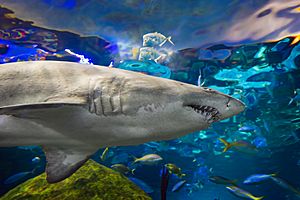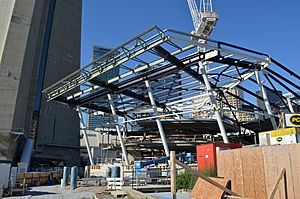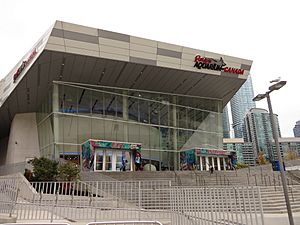Ripley's Aquarium of Canada facts for kids
 |
|
| Date opened | October 16, 2013 |
|---|---|
| Location | 288 Bremner Boulevard Toronto, Ontario M5V 3L9 |
| Coordinates | 43°38′33″N 79°23′10″W / 43.642481°N 79.38605°W |
| No. of animals | 16,000 |
| Volume of largest tank | 2,840,000 litres (750,000 US gal) |
| Total volume of tanks | 5,700,000 litres (1,506,000 US gal) |
Ripley's Aquarium of Canada is a fun place to visit in Toronto, Ontario, Canada. It's an aquarium where you can see many different water animals. This aquarium is one of three owned by Ripley Entertainment. You can find it in downtown Toronto, right next to the famous CN Tower.
The aquarium is home to 5.7 million liters (about 1.25 million gallons) of water. This water holds marine (ocean) and freshwater animals from all over the world. You can discover over 20,000 amazing sea and freshwater creatures. These animals belong to more than 450 different kinds of species.
Contents
History of Ripley's Aquarium
Ripley's first thought about building an aquarium in Niagara Falls, Ontario, around 2004. But their plans changed, and they decided to build it in Toronto instead. Building the aquarium started in August 2011. It cost about $130 million to build. The aquarium opened its doors to visitors in October 2013.
Different levels of government helped make the aquarium happen. The Canadian government gave $10 million to improve the area around the aquarium. This helped connect it to places like the CN Tower. The Ontario government added $11 million to the project. The City of Toronto also helped by reducing property taxes for the aquarium for its first twelve years.
Exploring the Aquarium Building
The aquarium building looks very cool. It has a unique shape covered in large aluminum panels. The roof of the main entrance looks like the Earth's crust is peeling back. This gives you the feeling of looking into the amazing underwater world. The building also has special features to make sure its electrical systems do not bother the sharks inside.
How to Get to the Aquarium
The aquarium is on Bremner Boulevard. It is east of the Rogers Centre and south of the CN Tower. It's also across the street from the Roundhouse Railway Museum. You can easily get there from the Union subway station. Just use the SkyWalk pedestrian path. The aquarium does not have its own parking. But you can find parking in nearby underground garages or surface lots. If you are driving, the closest highway exit is York Street from the Gardiner Expressway.
Amazing Aquarium Exhibits
The aquarium has 5.7 million liters (1.5 million gallons) of water. It shows marine and freshwater habitats from all over the world. There are ten main areas, called galleries, to explore. These include Canadian Waters, Rainbow Reef, Dangerous Lagoon, Discovery Centre, The Gallery, Ray Bay, Swarm: Nature by Numbers, Planet Jellies, Life Support Systems, and the Shoreline Gallery. Over 20,000 animals live here.
- Canadian Waters: This exhibit shows animals from the waters around Canada. It has 17 different habitats. You can see animals like alewife, largemouth bass, American lobster, wolf eel, lump fish, giant pacific octopus, and china rockfish.
- Rainbow Reef: This is the most colorful part of the aquarium. It features animals from the Indo-Pacific ocean regions. Some animals here include the Picasso triggerfish, humbug dascyllus, emperor angelfish, pajama cardinalfish, and unicorn surgeonfish. You can also watch an interactive dive show here.
- Dangerous Lagoon:
 The Dangerous Lagoon exhibit includes several species of sharks, roughtail stingrays, longcomb sawfish, and green sea turtles.
The Dangerous Lagoon exhibit includes several species of sharks, roughtail stingrays, longcomb sawfish, and green sea turtles.
This is the aquarium's largest tank. You walk through an underwater tunnel on a moving conveyor belt. This lets you get a close look at amazing creatures. You might see sand tiger sharks, sandbar sharks, roughtail stingrays, longcomb sawfish, and green sea turtles.
- Discovery Centre: This area has many hands-on activities. You can look through underwater viewing bubbles. There's also a pop-up research submarine. A touch pool lets you gently touch living fossils. Animals in this area include clownfish, palette surgeonfish, and horseshoe crab. In the touch exhibits, aquarium staff help you touch the skin of sharks and stingrays. This gallery is home to whitespotted bamboo sharks, brownbanded bamboo sharks, southern stingrays, and cownose rays.
- The Gallery: Also called Mother Nature's Art Gallery, this exhibit shows delicate underwater species. You can see the red lionfish, electric eel, lined seahorse, and the archerfish. This exhibit has six saltwater tanks and three freshwater tanks.
- Planet Jellies: This exhibit features five different kinds of jellyfish. The displays change colors, making the jellyfish look even more magical. You can see pacific sea nettles, moon jellys, spotted jellys, and upside-down jellys.
- Ray Bay: This exhibit focuses on three different kinds of stingrays. Sometimes, you can even watch aquarium divers feeding the stingrays during their daily shows. Animals here include the bonnethead shark, cownose ray, and the southern stingray.
- Life Support Systems: This gallery gives you a peek behind the scenes. You can see the equipment that keeps the animals healthy and the water clean. Ripley's Aquarium of Canada has the biggest life support system room of all Ripley's aquariums. This area shows the equipment used for the Dangerous Lagoon and Ray Bay exhibits.



